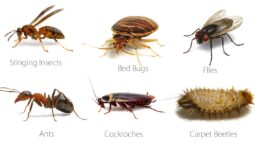As embarrassing as it may seem, I’ve encountered bedbugs in my home. They have feasted on my blood and made me pretty uncomfortable.
So, just like you, who are experiencing bed bug attacks, we are left to find eradicating techniques and answers to a pressing question: How long can bed bugs live without food?
What Are Bedbugs?
Bedbugs are tiny, egg-shaped, brownish bugs that live off animal and human blood. Mature bedbugs have flat abdomens the size of an apple seed. However, when they feed, their abdomen swells up and gets reddish.
Bedbugs can’t fly, but those tiny creatures can run faster than Usain Bolt when they sense themselves in danger. They are swift on walls, floors, ceilings, and unimaginable surfaces.
The quirky thing is that their females lay hundreds of eggs all over. So, when you have a couple of infestations, expect a colony shortly after. They are pretty fertile, I tell you!
Baby bedbugs, known as nymphs, grow by shedding their skins five times before clocking adulthood. To reach this feat, they must feed, and on what?
Our blood! And, of course, that of our lovely pets. Under suitable conditions, these bugs can mature in a month and procreate more than three generations in a year.
There is no news of them transmitting diseases even though they are painful nuisances.
Bedbugs infiltrate your homes stealthily through clothing, luggage, beddings, and couches from infested areas; the slightest fraternizing with infested places can give you many of those creatures.
Their flat shapes and transparency make it almost impossible to get detected unless they are on the move. They can fit into small spaces the width of a debit card.
Bedbugs do not nest like bees or ants, but they live in groups in hidden places. Their best hiding spots are the edges of mattresses, bed frames, and couches, where they can easily access food at night.
In weeks, bedbugs may go on unending tours around your home, exploring crevices and sourcing shelter in covered places. They may also travel out to other homes and apartments in the area.
Since bedbugs feed solely on blood meals, it is not attached to dirty homes. They can be found in sparkly homes as they are in filthy ones.
The Bite of a Bed Bug
They hunt at night and usually attack us while we are asleep. They feed by penetrating the skin with their beak and sucking out blood. They do this for about three to ten minutes, then quietly crawl away.
A bite from a bedbug is painless at first, but sometimes, you’ll feel a sharp sting that’s bound to drive that lovely sleep out of your eyes.
If you’re lucky, you’ll see the bug running for dear life, and if you’re fast enough, you’ll be able to send the tiny insect to the abyss. Mind you, they release a foul odor when squashed.
You should probably hold your breath when killing them and then wash your hands afterward.
What Are the Life Stages of Bedbugs?
Knowledge of bedbugs’ life cycles clarifies how they operate and sheds more light on the question, ‘How long can bed bugs live without food?’ You’d probably soon discern the answers yourself.
Bed Bugs and Eggs
The life of a bed bug begins when an egg is laid. The eggs are grainy and milky in color. Female bed bugs produce one to five eggs daily and can lay up to 500 in a lifetime.
These eggs are found individually or in clusters in hidden places where they can hatch successfully. In two weeks, these eggs hatch, releasing a flood of tiny bed bugs that commence feeding immediately.
Bed Bug and Nymphs
These young bed bugs, or nymphs, go through five molts stages before maturity. Nymphs look like adult bugs but are smaller and not sexually mature.
Younger nymphs are slightly yellow, while the older ones are reddish-brown. For a nymph to complete its molting stage, it needs to feed on blood.
In a conducive environment that is room temperature, a nymph can molt into an adult in just five weeks.
Bedbugs and Adulthood
Once they reach adulthood, all they require is to feed till the end of their life span or when they get unfortunate and get swashed under your furious hands.
Signs of a Bedbug Infestations
If you wake up with an itch that wasn’t there when you went to sleep, you probably have bedbugs, especially if you recently acquired used bedding or furniture around the time the itch started.
Some other signs include:
- Bloodstains on your mattress, sheets, cushions, or pillowcases
- Black or rusty patches on bedding, walls, sheets, etc.
- Shed insect skin: tiny, oval-shaped eggs attached to hidden places on your bedding and furniture.
- A disgusting, musty odor exudes from the bugs’ glands.
If you suspect bedbugs, remove and check all nooks and crannies of bedding, walls, and furniture for signs of their presence.
Also, look inside books, radios, or telephones, the edges of your rugs and carpet, and even electrical outlets. Scrutinize your closet because bedbugs can attach themselves to your clothing.
If you are unsure what to look for, seek the tutelage of an exterminator who knows what to look for and where to look.
If you find signs of infestation, begin steps to get rid of the bugs and prevent their return.
What Do Bed Bugs Feed on?
Well, it should be clear by now. Those critters feed on blood! Our blood!!!
How Often Do Bed Bugs Feed?
It’s been registered that they go on their feeding spree mostly when you’re sleeping, resting, or during nighttime.
A single bed bug can feast on you more than once when lying on a mattress until it is saturated. This is why you’d see trails of blood on your skin where you’d been bitten.
The number of bedbugs that can feed off your blood strongly depends on the level of infestation, their density in the area you’re lying on, and the number of blood bags (humans and animals) readily available for them.
Bedbug bites are not painful at first. They leave a red spot that becomes itchy as time passes. The marks of their bites can disappear in a day or two.
Even though bed bug bites are not harmful, they can cause an allergic reaction or even lead to a condition known as anaphylaxis. This condition is a highly life-threatening allergic reaction caused by an allergy.
If the infestation is low, you might have one or two bites daily. However, if there is a severe infestation, you can suffer from more than 50 bed bug bites per night.
Any human should regularly inspect the furniture and spring box in the house and kill any bed bugs when found.
How Long Can Bed Bugs Live Without Food?
You’ve been equipped with what these creatures look like, their life cycle, and how to detect them. Now, we’d be looking into how long bed bugs live without food.
The answer to the question ‘How long can bed bugs live without food?’ is embedded in the age of the bed bug, its habitat, and the temperature it is exposed to.
Age of Bed Bug
An average bed bug can survive for 20 to 400 days before its next feeding if it resides in a conducive environment.
Some adults can survive longer than 400 days at low temperatures. This means you’d probably think you’ve gotten rid of everything when a couple is sitting it out in the crevices of that cloth you’ve not worn for long.
Since nymphs go through stages before becoming adults and need blood for molting, they are fed more often than an adult bed bug.
When they lack the food they require, they die. Newly hatched bed bugs can survive a few weeks without a blood meal.
A bed bug sucks on its host for a few minutes during its feeding time. The length of food consumption depends on its developmental stage, the quantity consumed in the last feeding session, and the time it is the last fed.
Once the bed bug is full, it crawls back to its home, crevices and cracks in furniture, where the rest of the family are gathered.
One of the reasons you’d feel like an army of bedbugs has attacked you is their rapid spread. You can wake up every morning to new bites from different bugs, which can stress you a lot and give you sleepless nights.
Do not let these insects get the best out of you. An exterminator or a professional pest control company can help you eliminate them.
Some other studies revealed that adult bed bugs could live up to a year without feeding. One study even divulged that bed bugs could survive for up to 18 months without a food source as long as they are in an optimal environment.
Habitat
Another factor that influences their survival and feeding is the activity level of these bugs and their habitat.
Bed bugs that have their colony closer to bed frames, bed foams, or other furniture have to travel lesser distances searching for food. It is like the typical breakfast in bed.
If they don’t have to go too far for food, they can conserve the one they already have, which will help them stay longer without a food source.
Bugs that travel longer distances for food tend to exhaust their reserved energy on several to and for movement to their feeding site.
When they travel longer, they need more feeding than those close to their feeding site.
The farther away from home a bug ventures, the higher the chances of it getting killed by angry hosts, not that bugs that live closer don’t get squashed, too.
A person can go as far as sourcing out the bug’s location and eradicating the entire colony. All the same, the nearer the habitat, the greater the chances of survival for bed bugs.
Temperature
The temperature also plays a vital role in bed bug survival, feeding, and activity. In cold living conditions, such as air conditioners and cold weather, bed bugs use less energy, and there is less activity as they remain dormant.
However, the bugs use more energy in hot conditions, so they need to feed more to keep living. Entomologists conducted a detailed study in 2019.
Different bed bugs were fed just once and left to molt into their first stage, with no subsequent feeding. The beg bugs’ time of survival varied significantly at different temperatures.
In the research, bed bugs in their first nymph molt stage lasted for 28 days at 80 degrees Fahrenheit, and those kept at 98.6 degrees lasted for just 17 days.
Nymphs feed for 2-5 minutes, while adults can feed for up to 10 minutes. Adult females need food more often than males because they lay eggs regularly.
Their feeders are generally small, and their bites are sting-free. You’d only feel a sting a few minutes after the bed bug has finished.
This is probably why the bed bug must have been long gone when the sting awakes you. Hosts with sensitive skin feel the sting a bit faster than others.
I know I’ve answered the question, ‘How long can bed bugs live without food?’. But, I’d love to further this knowledge by informing you about possible ways to eradicate bed bug infestation. Your comfort is dear to me.
Bedbug Treatments and Control Measures
You’d start by cleaning the whole place, including their hideout, shells, and fecal produce. It can be carried out in the following ways:
- Hot water/ heat treatment: Wash linens, curtains, sheets, and other washable materials in hot water and dry them on the highest dryer level. Use the same dryer setting for 30 minutes for non-washable materials and furniture.
- Scrub mattress seams with a stiff brush to remove bedbugs and eggs, then vacuum afterward.
- Vacuum your home frequently. Once done, dispose of the garbage immediately so the bed bugs won’t crawl back into your home.
- Use tightly covered bed and pillow casing to prevent bugs from creating a home from your comfort pillow.
- Repair cracks and holes in walls; wooden and plastic furniture. Tightly glue back peeling wallpapers to prevent creating a hiding place for the bugs. Plaster and glue down peeling wallpaper to remove places bedbugs can hide.
- Remove clutters around the bed.
If you have an infested mattress, you should probably get rid of it and get a new one. However, your new bed will become infected if your home is not bug-free.








